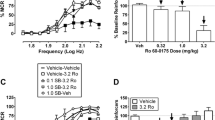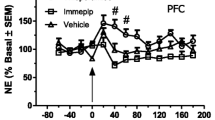Abstract
Rationale
The serotonergic (5-hydroxytryptamine, 5-HT) system is extensively implicated in feeding behavior. In recent years, 5-HT receptors have been classified into 14 subtypes, and activation of 5-HT1B and 5-HT2C receptors inhibits food intake in rats. However, the precise functions in local brain areas of these receptor subtypes are unclear.
Objectives
Frontal cortex (FC), lateral hypothalamic area (LH), or ventromedial hypothalamic nucleus (VMH) are involved in control of feeding behavior. We investigated the effects of 5-HT1B and 5-HT2C receptor stimulations in the three local brain areas on feeding behavior and on 5-HT metabolism.
Methods
We perfused mCPP, 5-HT1B/2C agonist, at multiple doses via a microdialysis probe into the three local brain areas and observed food intake. Extracellular concentrations of 5-HT and 5-HIAA were measured simultaneously.
Results
Perfusion of 1 mM mCPP into VMH, but not into LH nor FC at any dose, induced significant reduction of food intake compared with control. The extracellular concentrations of 5-HT were markedly increased in all three areas, but the concentrations of 5-HIAA were not changed by mCPP perfusions.
Conclusions
These results indicate that the effects of 5-HT1B or 5-HT2C receptor activation on feeding behaviors depended on the brain regions, and that 5-HT1B or 5-HT2C receptors in VMH, but not in FC or in LH, play important roles in the regulation of food intake. The results also suggested that mCPP acts not only as a 5-HT1B/2C agonist, but also as a 5-HT releaser or as a re-uptake inhibitor. Further studies using antagonists should be conducted.




Similar content being viewed by others
References
Abramowski D, Rigo M, Duc D, Hoyer D, Staufenbiel M (1995) Localization of the 5-hydroxytryptamine2C receptor protein in human and rat brain using specific antisera. Neuropharmacology 34:1635–1645
Aulakh CS, Hill JL, Yoney HT, Murphy DL (1992) Evidence for involvement of 5-HT1C and 5-HT2 receptors in the food intake suppressant effects of 1-(2,5-dimethoxy-4-iodophenyl)-2-aminopropane (DOI). Psychopharmacology 109:444–448
Aulakh CS, Mazzola-Pomietto P, Hulihan-Giblin BA, Murphy DL (1995) Lack of cross-tolerance for hypophagia induced by DOI versus m-CPP suggests separate mediation by 5-HT2A and 5-HT2C receptors, respectively. Neuropsychopharmacology 13:1–8
Barnes NM, Sharp T (1999) A review of central 5-HT receptors and their function. Neuropharmacology 38:1083–1152
Baumann MH, Rutter JJ, Auerbach SB (1993) Intravenous administration of the serotonin agonist m-chlorophenylpiperazine (mCPP) increases extracellular serotonin in the diencephalon of awake rats. Neuropharmacology 32:1381–1386
Bray GA, York DA (1979) Hypothalamic and genetic obesity in experimental animals: an autonomic and endocrine hypothesis. Physiol Rev 59:719–809
Bruinvels AT, Landwehrmeyer B, Gustafson EL, Durkin MM, Mengod G, Branchek TA, Hoyer D, Palacios JM (1994) Localization of 5-HT1B, 5-HT1D alpha, 5-HT1E and 5-HT1F receptor messenger RNA in rodent and primate brain. Neuropharmacology 33:367–386
Clemett DA, Punhani T, Duxon MS, Blackburn TP, Fone KC (2000) Immunohistochemical localisation of the 5-HT2C receptor protein in the rat CNS. Neuropharmacology 39:123–132
Clifton PG, Lee MD, Dourish CT (2000) Similarities in the action of Ro 60-0175, a 5-HT2C receptor agonist and d-fenfluramine on feeding patterns in the rat. Psychopharmacology 152:256–267
Clifton PG, Lee MD, Somerville EM, Kennett GA, Dourish CT (2003) 5-HT1B receptor knockout mice show a compensatory reduction in 5-HT2C receptor function. Eur J Neurosci 17:185–190
Cloez-Tayarani I, Cardona A, Rousselle JC, Massot O, Edelman L, Fillion G (1997) Autoradiographic characterization of 3H-5-HT-moduline binding sites in rodent brain and their relationship to 5-HT1B receptors. Proc Natl Acad Sci USA 94:9899–9904
De Vry J, Schreiber R (2000) Effects of selected serotonin 5-HT(1) and 5-HT(2) receptor agonists on feeding behavior: possible mechanisms of action. Neurosci Biobehav Rev 24:341–353
Dourish CT, Clark ML, Iversen SD (1988) 8-OH-DPAT elicits feeding and not chewing: evidence from liquid diet studies and a diet choice test. Psychopharmacology 95:185–188
Eriksson E, Engberg G, Bing O, Nissbrandt H (1999) Effects of mCPP on the extracellular concentrations of serotonin and dopamine in rat brain. Neuropsychopharmacology 20:287–296
Fetissov SO, Meguid MM, Chen C, Miyata G (2000) Synchronized release of dopamine and serotonin in the medial and lateral hypothalamus of rats. Neuroscience 101:657–663
Fletcher PJ, Davies M (1990) A pharmacological analysis of the eating response induced by 8-OH-DPAT injected into the dorsal raphe nucleus reveals the involvement of a dopaminergic mechanism. Psychopharmacology 100:188–194
Freeman KA, Tallarida RJ (1994) A quantitative study of dopamine control in the rat striatum. J Pharmacol Exp Ther 268:629–638
Gibson EL, Barnfield AM, Curzon G (1994) Evidence that mCPP-induced anxiety in the plus-maze is mediated by postsynaptic 5-HT2C receptors but not by sympathomimetic effects. Neuropharmacology 33:457–465
Halford JC, Lawton CL, Blundell JE (1997) The 5-HT2 receptor agonist MK-212 reduces food intake and increases resting but prevents the behavioural satiety sequence. Pharmacol Biochem Behav 56:41–46
Halford JC, Wanninayake SC, Blundell JE (1998) Behavioral satiety sequence (BSS) for the diagnosis of drug action on food intake. Pharmacol Biochem Behav 61:159–168
Jacobs BL, Azmitia EC (1992) Structure and function of the brain serotonin system. Physiol Rev 72:165–229
Kahn RS, Wetzler S (1991) m-Chlorophenylpiperazine as a probe of serotonin function. Biol Psychiatry 30:1139–1166
Kennett GA, Curzon G (1988a) Evidence that hypophagia induced by mCPP and TFMPP requires 5-HT1C and 5-HT1B receptors; hypophagia induced by RU 24969 only requires 5-HT1B receptors. Psychopharmacology 96:93–100
Kennett GA, Curzon G (1988b) Evidence that mCPP may have behavioural effects mediated by central 5-HT1C receptors. Br J Pharmacol 94:137–147
Kennett GA, Dourish CT, Curzon G (1987) 5-HT1B agonists induce anorexia at a postsynaptic site. Eur J Pharmacol 141:429–435
Kennett GA, Whitton P, Shah K, Curzon G (1989) Anxiogenic-like effects of mCPP and TFMPP in animal models are opposed by 5-HT1C receptor antagonists. Eur J Pharmacol 164:445–454
Kennett GA, Wood MD, Bright F, Trail B, Riley G, Holland V, Avenell KY, Stean T, Upton N, Bromidge S, Forbes IT, Brown AM, Middlemiss DN, Blackburn TP (1997) SB 242084, a selective and brain penetrant 5-HT2C receptor antagonist. Neuropharmacology 36:609–620
Kitchener SJ, Dourish CT (1994) An examination of the behavioural specificity of hypophagia induced by 5-HT1B, 5-HT1C and 5-HT2 receptor agonists using the post-prandial satiety sequence in rats. Psychopharmacology 113:369–377
Klodzinska A, Chojnacka-Wojcik E (1992) Hyperthermia induced by m-trifluoromethylphenylpiperazine (TFMPP) or m-chlorophenylpiperazine (m-CPP) in heat-adapted rats. Psychopharmacology 109:466–472
Kolb B (1984) Functions of the frontal cortex of the rat: a comparative review. Brain Res 320:65–98
Lee MD, Kennett GA, Dourish CT, Clifton PG (2002) 5-HT1B receptors modulate components of satiety in the rat: behavioural and pharmacological analyses of the selective serotonin1B agonist CP-94,253. Psychopharmacology 164:49–60
Leibowitz SF, Alexander JT, Cheung WK, Weiss GF (1993) Effects of serotonin and the serotonin blocker metergoline on meal patterns and macronutrient selection. Pharmacol Biochem Behav 45:185–194
Lucas JJ, Yamamoto A, Scearce-Levie K, Saudou F, Hen R (1998) Absence of fenfluramine-induced anorexia and reduced c-Fos induction in the hypothalamus and central amygdaloid complex of serotonin 1B receptor knock-out mice. J Neurosci 18:5537–5544
Lucki I, Ward HR, Frazer A (1989) Effect of 1-(m-chlorophenyl)piperazine and 1-(m-trifluoromethylphenyl)piperazine on locomotor activity. J Pharmacol Exp Ther 249:155–164
Meguid MM, Fetissov SO, Blaha V, Yang ZJ (2000) Dopamine and serotonin VMN release is related to feeding status in obese and lean Zucker rats. Neuroreport 11:2069–2072
Mori RC, Guimaraes RB, Nascimento CM, Ribeiro EB (1999) Lateral hypothalamic serotonergic responsiveness to food intake in rat obesity as measured by microdialysis. Can J Physiol Pharmacol 77:286–292
Paxinos G, Watson C (1986) The rat brain in stereotaxic coordinates, 2nd edn. Academic Press, New York
Pazos A, Palacios JM (1985) Quantitative autoradiographic mapping of serotonin receptors in the rat brain. I. Serotonin-1 receptors. Brain Res 346:205–230
Pettibone DJ, Williams M (1984) Serotonin-releasing effects of substituted piperazines in vitro. Biochem Pharmacol 33:1531–1555
Protais P, Windsor M, Mocaer E, Comoy E (1995) Post-synaptic 5-HT1A receptor involvement in yawning and penile erections induced by apomorphine, physostigmine and mCPP in rats. Psychopharmacology 120:376–383
Samanin R, Mennini T, Ferraris A, Bendotti C, Borsini F, Garattini S (1979) Chlorophenylpiperazine: a central serotonin agonist causing powerful anorexia in rats. Naunyn-Schmiedeberg’s Arch Pharmacol 308:159–163
Schreiber R, Selbach K, Asmussen M, Hesse D, de Vry J (2000) Effects of serotonin(1/2) receptor agonists on dark-phase food and water intake in rats. Pharmacol Biochem Behav 67:291–305
Schwartz DH, McClane S, Hernandez L, Hoebel BG (1989) Feeding increases extracellular serotonin in the lateral hypothalamus of the rat as measured by microdialysis. Brain Res 479:349–354
Schwartz DH, Hernandez L, Hoebel BG (1990) Serotonin release in lateral and medial hypothalamus during feeding and its anticipation. Brain Res Bull 25:797–802
Simansky KJ (1996) Serotonergic control of the organization of feeding and satiety. Behav Brain Res 73:37–42
Spergel D, Lahiri S (1993) Differential modulation by extracellular ATP of carotid chemosensory responses. J Appl Physiol 74:3052–3056
Tao R, Ma Z, Auerbach SB (2000) Differential effect of local infusion of serotonin reuptake inhibitors in the raphe versus forebrain and the role of depolarization-induced release in increased extracellular serotonin. J Pharmacol Exp Ther 294:571–579
Tecott LH, Sun LM, Akana SF, Strack AM, Lowenstein DH, Dallman MF, Julius D (1995) Eating disorder and epilepsy in mice lacking 5-HT2c serotonin receptors. Nature 374:542–546
Verge D, Daval G, Marcinkiewicz M, Patey A, el Mestikawy S, Gozlan H, Hamon M (1986) Quantitative autoradiography of multiple 5-HT1 receptor subtypes in the brain of control or 5,7-dihydroxytryptamine-treated rats. J Neurosci 6:3474–3482
Vickers SP, Clifton PG, Dourish CT, Tecott LH (1999) Reduced satiating effect of d-fenfluramine in serotonin 5-HT(2C) receptor mutant mice. Psychopharmacology 143:309–314
Voigt JP, Sohr R, Fink H (1998) CCK-8S facilitates 5-HT release in the rat hypothalamus. Pharmacol Biochem Behav 59:179–182
Voigt JP, Kienzle F, Sohr R, Rex A, Fink H (2000) Feeding and 8-OH-DPAT-related release of serotonin in the rat lateral hypothalamus. Pharmacol Biochem Behav 65:183–189
Wang P, Aulakh CS, Hill JL, Murphy DL (1988) Fawn hooded rats are subsensitive to the food intake suppressant effects of 5-HT agonists. Psychopharmacology 94:558–562
Zuardi AW (1990) 5-HT-related drugs and human experimental anxiety. Neurosci Biobehav Rev 14:507–510
Acknowledgements
This study was supported by Osaka City University Medical School.
Author information
Authors and Affiliations
Corresponding author
Rights and permissions
About this article
Cite this article
Hikiji, K., Inoue, K., Iwasaki, S. et al. Local perfusion of mCPP into ventromedial hypothalamic nucleus, but not into lateral hypothalamic area and frontal cortex, inhibits food intake in rats. Psychopharmacology 174, 190–196 (2004). https://doi.org/10.1007/s00213-003-1735-0
Received:
Accepted:
Published:
Issue Date:
DOI: https://doi.org/10.1007/s00213-003-1735-0




